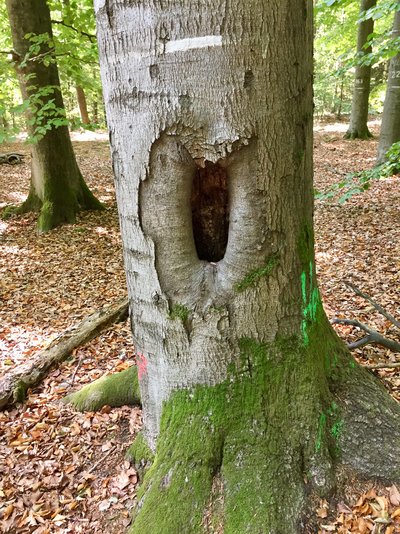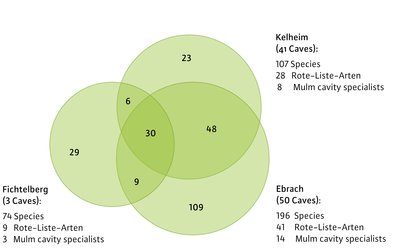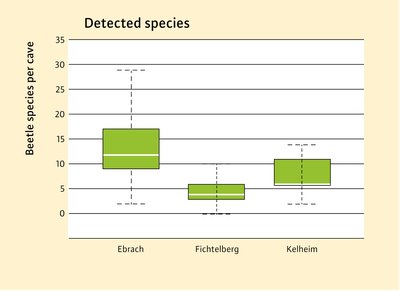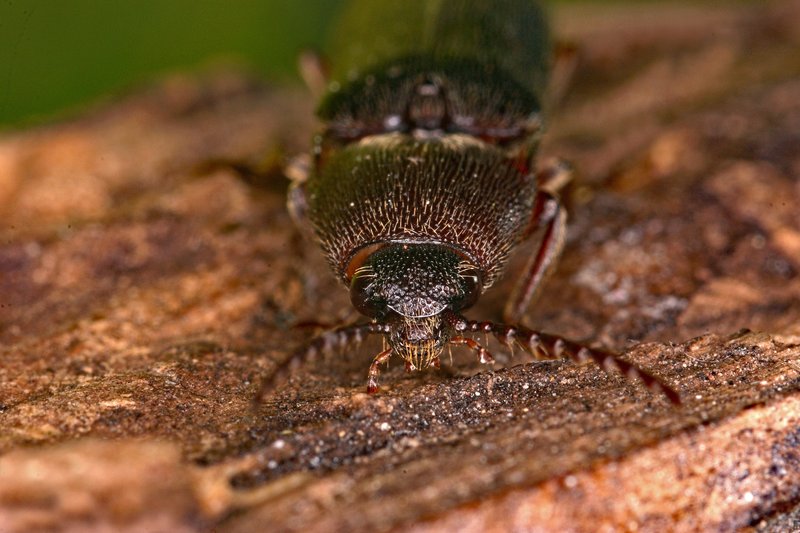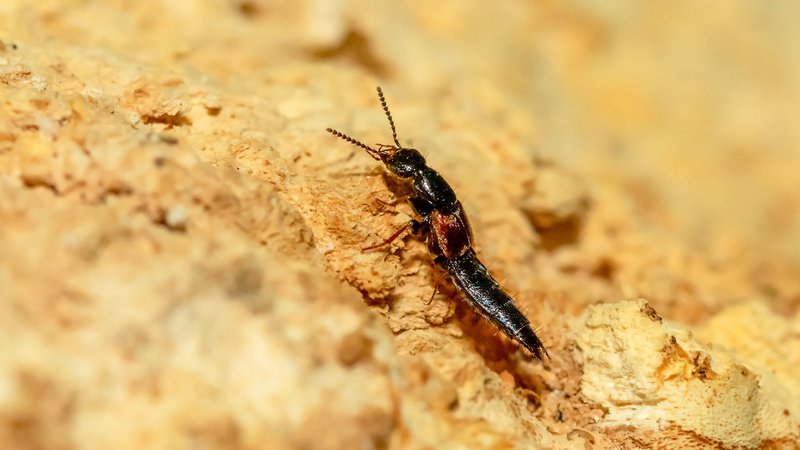An important habitat type for species diversity in forests are so-called mulm caves - rotting cavities in living trees, which usually develop in old deciduous trees (conifers make the formation of caves more difficult due to the strong resin flow).
Mulm caves form mainly in older trees and take many years to develop. In oaks, for example, the probability of cave formation increases sharply from an age of around 200 years.
Xylobiont mulm cave dwellers - living space is scarce
Animals that are directly or indirectly dependent on deadwood during at least one phase of their life cycle are known as saproxylic. It is estimated that 34 % of all species occurring in central European forests are saproxylic, and in the case of forest-dwelling beetles, more than 50 % are regarded as saproxylic. Saproxylic species thus make a major contribution towards species diversity in the forest. They are also important for the nutrient cycle in the forest, as they play a key role in the decomposition of deadwood.
Mulm caves provide habitats for numerous groups of animals. The largest group consists of arthropods, especially flies and mosquitoes (Diptera), beetles (Coleoptera), but also mites (Acari) and springtails (Collembola). Mulm caves are also a habitat for cavity-nesting birds and mammals such as bats. Consequently, mulm caves are key structures for a high level of biodiversity in the forest. As old hollow trees were often removed in the past due to their low economic value, mulm caves are now among the rarest structures in central European forests. This habitat shortage means that cave-dependent tree hollow specialists among the beetles, i.e. those species whose larvae can only develop in mulm caves, are among the most endangered groups of animals. Around 75 % of them are on the Red List.
In terms of their characteristics, mulm caves are as diverse as their inhabitants. There are large and small mulm caves, caves with large or small entrances, moist and less moist caves, caves with coarse, less decomposed mulm or those with dark, heavily decomposed mulm. The habitat requirements of the mulm cave dwellers are also very different. Some species only colonise very damp hollows, others only hollows low down on the tree, in contact with the forest floor, or only large hollows. These special requirements of many species further reduce the supply of suitable mulm caves.
Forestry research: a comparison of three forest areas
The project “Arthropod communities in tree hollows in a landscape context: Influence of forest and landscape structure on diversity and dispersal distances in a regional comparison” refers to a total of three state forest enterprises of the Bayerische Staatsforsten (BaySF) with different tree species composition. The aim of this study was to investigate on larger spatial scales the effects of landscape and forest structure (e.g. amount of deadwood, tree species composition, age structure) on the species diversity of arthropods in mulm caves and their dispersal distances, using regularly collected BaySF forest inventory and remote sensing data. Findings from previous studies, which mainly dealt with local factors of mulm caves and hollow trees, were also validated in the three forest areas.
The three areas studied were the Ebrach state forest enterprise, which has predominantly oak and beech stands, the Kelheim state forest enterprise, which has mixed deciduous and coniferous forests, and the Fichtelberg forest enterprise, characterised by montane, almost exclusively spruce stands with the occasional deciduous tree (Figure 2). In the years 2018 and 2019, in each of the three forest areas, samples were taken once each from 40 to 50 mulm caves in common beech, using emergence traps. The insects emerging from the mulm caves from April to September were thus captured. The larval development of mulm cave dwelling beetles usually extends over several years. Consequently, larvae that had not yet completed their development in the year of sampling remained in the hollows, and may hatch in subsequent years.

Fig. 2: Environmental factors influencing the species diversity of saproxylic beetles in the investigated mulm caves. Green arrow = positive influence (e.g. the larger the entrance to the hollow, the higher the species diversity), red arrow = negative influence (e.g. the higher the degree of decomposition of the mulm, the lower the species diversity). The respective tree species composition of the three forest areas is visualised by the ratio of deciduous and coniferous trees in the circles.
Local characteristics of the mulm caves of great importance
A total of 283 saproxylic beetle species from 48 families (5,880 individuals) were collected in the 134 mulm caves sampled in the three study areas. Of these, 62 species are on the Red List, corresponding to a 22 % share of threatened species. 16 species were identified as mulm cave specialists, all of which are on the Red List. The number of species detected as well as the composition of the species communities differed significantly in some cases between the three forest areas studied (Figure 3 and 4).
Mulm caves in the Ebrach state forestry area showed the greatest species diversity per hollow (an average of 13.2 beetle species per hollow, Fichtelberg: 4.6, Kelheim: 7.9), as well as the highest number of endangered species and tree cavity specialists. It was found that the species diversity was particularly influenced by the local characteristics of the mulm caves themselves as well as the hollow trees (Figure 2). For example, more beetle species were thus found in mulm caves with large entrances and in hollows close to the ground. Furthermore, there were more beetle species in caves with still slightly decomposed and correspondingly lighter and coarser-grained mulm than in caves with already more decomposed mulm. The still fresh mulm can probably be used by a larger number of generalist saproxylic species, too, while the strongly decomposed, dark mulm is mainly accepted by just a few species that specialise in these stages of decomposition.
Importance of forest structure
The species diversity in the mulm caves was mainly investigated with regard to the influence of the forest structure within a radius of up to 500 m around the tree hollows. For this purpose, we were able to use the regularly collected forest inventory data of the BaySF state forestry company, which use a grid of inventory points (200 m x 200 m) to record numerous parameters of forest structure (e.g. amount of deadwood, breast height diameter of the surrounding trees, tree species composition). After interpolation of the point data and evaluation of the maps created especially for this purpose, it became apparent that the above described influence of local mulm cave characteristics on the species diversity in the hollows always also depends on the forest structure of the area in question. In the forest areas with a higher proportion of deciduous trees (Ebrach and Kelheim), the influence of local mulm cave characteristics was more pronounced than in the Fichtelberg forestry area, which is dominated by conifers.
In the Fichtelberg area, there are only a few isolated mulm caves in deciduous trees. If mulm caves are rare and the only ones in an area, the quality of the individual hollows hardly seems to matter - mulm cave dwellers take what they can get. In the coniferous forest, only the proportion of beech trees in the immediate vicinity of the investigated tree caves thus had a positive influence on the species diversity in the hollows (Figure 2). Since beech trees in the Fichtelberg forest area mostly stand on their own in an environment of conifers, the presence of other beech trees in the closer vicinity of the cave trees (within a radius of up to 100 m) was the most important influencing factor for mulm cave dwelling beetles in this forest area.
Not all deadwood is the same
In the Steigerwald forest (Ebrach state forest enterprise), the area with the highest proportion of deciduous trees in our study, it was especially the amount of deadwood in the vicinity of the tree caves (up to a radius of 100 m) that had a positive influence on species diversity in the hollows, as well as the local tree hollow characteristics (Figure 2). This could be due to the large proportion of deadwood generalists among the beetles in the hollows, which, in contrast to the mulm cave specialists, can use diverse deadwood structures as a habitat, and benefit from a greater supply of deadwood in the surrounding area. In Fichtelberg and Kelheim, on the other hand, which have lower proportions of deciduous trees, no correlation between the amount of deadwood in the immediate vicinity and the beetle species diversity in the hollows could be shown. Besides a sufficient quantity of deadwood, the composition of the deadwood in terms of tree species, diameter, degree of decomposition or exposure to the sun was also of great importance for the saproxylic species diversity.
Insects that colonise mulm caves do not usually benefit from coniferous deadwood, but exclusively from deciduous deadwood. This explains why our study found no correlation between the amount of deadwood in the Fichtelberg forestry area and the species diversity in the mulm caves.
Influence of landscape structure on mulm cave dwellers
In addition to local mulm cave characteristics and forest structure (within a radius of up to 500 m), the influence of landscape structure over larger areas of up to 5,000 m around the mulm caves was investigated. Satellite data was used to analyse the ratio of habitat (deciduous forest) to non-habitat (coniferous forest and open land) in the landscape surrounding the tree caves. We were able to show that the influence of landscape structure on the species diversity in the mulm caves is significantly lower than the influence of local mulm cave characteristics or elements of forest structure such as the amount of deadwood. However, it is worth noting that the influence of landscape structure was more pronounced for the Red List species. Consequently, endangered saproxylic beetle species are more sensitive to habitat availability in the surrounding landscape than non-endangered species. Extremely rare “virgin forest relict species” (in our study the click beetle Crepidophorus mutilatus) are known to require habitats of high-quality.
Low dispersal ability of mulm cave specialists?
The ability of most mulm cave dwelling beetle species to disperse is still unknown. Within the context of our study, we therefore carried out genetic analyses for the populations of two selected saproxylic beetle species. The two mulm cave specialists, the comb-clawed beetle Eucnemis capucina and the short-winged beetle Hesperus rufipennis, showed - in contrast to the population genetics of deadwood generalists we had previously studied - a clear genetic structuring even within a forest area such as the Ebrach state forest enterprise. This could on the one hand be due to a low dispersal capacity of the beetles, which are adapted to the long-lived mulm cave habitat. On the other hand, specialists such as these often also have a very small population size, which would lead to similar patterns.
The bottom line
A consequence of the study for forestry practitioners is the protection and preservation of each developing and existing tree mulm caves, since each of these cavities offers a unique range of valuable microhabitats in its specific structure and characteristics. Given the rarity of mulm caves in commercially used forests and the very different habitat requirements of their inhabitants, all existing tree caves should be protected. Furthermore, in view of the decades it takes for mulm caves to develop, all trees that contain structures from which mulm caves could develop (e.g. bark injuries over large areas, broken-off branches), should be preserved.
The study shows that, in addition to the quality of the individual tree caves, the forest structure is also important for the species diversity of mulm cave dwellers. Consequently, an increase in the amount and quality of deadwood in commercially managed forests is also conducive to the protection of ecological communities in mulm caves.
Especially the amount of deadwood of deciduous tree species should be increased, as saproxylic beetles are sensitive not only to the quantity but also to the tree species, diameter, degree of decomposition and exposure to sunlight of the deadwood. The tree species composition of the respective forest area has also proven to have great influence on saproxylic species diversity in mulm caves. An increase in the proportion of deciduous trees in conifer-dominated commercially managed forests would thus also help to increase the species diversity of saproxylic beetles in tree cavities.
Summary
In the context of this study, the effects of landscape and forest structure on the species diversity of arthropods in tree caves and their dispersal distances were investigated. The study was carried out using forest inventory and remote sensing data on larger spatial scales, among other things.
The study shows that the quality of the individual mulm caves, the forest structure and the tree species composition are particularly important for the species diversity in the mulm caves. As mulm caves are key structures for a high level of biodiversity in the forest, special attention should be paid to the protection and conservation of this habitat.
The project “Arthropod communities in tree hollows in a landscape context: Influence of forest and landscape structure on diversity and dispersal distances in a regional comparison (L58)” (Project running period: 01.04.1918-31.12.2021) was, like its predecessor project L56, financed by the Bavarian State Ministry of Food, Agriculture and Forestry and the Oberfrankenstiftung, a foundation for the promotion of Upper Franconia.

